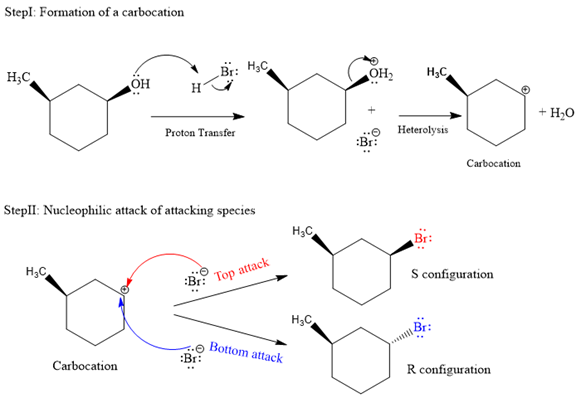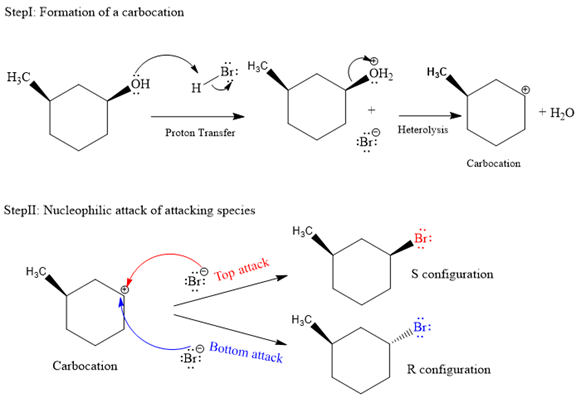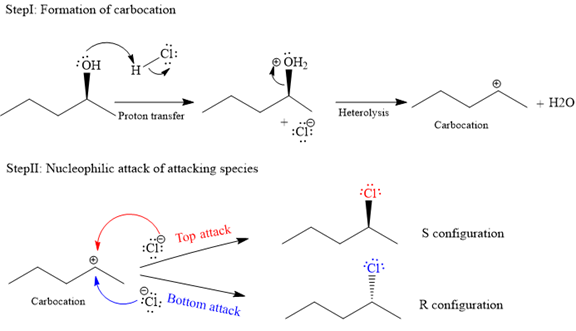
Concept explainers
(a)
Interpretation:
The complete and detailed mechanism is to be drawn for the given reaction.
Concept introduction:
The SN1 is an abbreviation for unimolecular nucleophilic substitution reaction. These reactions are two-step reactions. The first step is the formation of carbocation intermediate, followed by the nucleophilic attack, which is a second step. Due to the formation of a planar carbocation, the incoming nucleophile can attack the carbocation from two sides, either from the front of the plane or from the back side of the plane.
This leads to give the mixture of stereoisomers. When secondary and tertiary alcohols are treated with strong concentrated acids, it follows SN1 and E1 mechanism.
Answer to Problem 10.1P
The complete and detailed mechanism for given reaction is as follows:

Explanation of Solution
The given reaction is as follows:

The hydroxyl (
The departure of water is a slow step that leads to formation of carbocation, and thus it is the rate-determining step. Due to the formation of planar carbocation intermediate, the incoming nucleophile can attack from either sides, either the top (from above the plane) or bottom (from below of plane). The bromide ion formed in the proton transfer step is the attacking species in the second step of the mechanism. In the second step, the bromide ion (
Both top and bottom attack of nucleophile are possible leads to formation of the mixture of isomers, as shown below:

Due to the formation of carbocation intermediate in SN1 reaction, a mixture of stereoisomer is produced.
(b)
Interpretation:
The complete and detailed mechanism is to be drawn for the given reaction.
Concept introduction:
The SN1 is an abbreviation for unimolecular nucleophilic substitution reaction. These reactions are two-step reactions. The first step is the formation of carbocation intermediate, followed by the nucleophilic attack of attacking species, which is a second step. Due to the formation of a planar carbocation, the incoming nucleophile can attack the carbocation from two sides, either from the front of the plane or from the back side of the plane.
This leads to give the mixture of stereoisomers. When secondary and tertiary alcohols are treated with strong concentrated acids, it follows SN1 and E1 mechanism.
Answer to Problem 10.1P
The complete and detailed mechanism for given reaction is as follows:

Explanation of Solution
The given reaction is as follows:

The hydroxyl (
Both top and bottom attack of nucleophile are possible leads to formation of the mixture of isomers, as shown below:

Due to the formation of carbocation intermediate in SN1 reaction, a mixture of stereoisomer is produced.
Want to see more full solutions like this?
Chapter 10 Solutions
EBK GET READY FOR ORGANIC CHEMISTRY
- Predict the major organic product(s) of the following reactions. Include stereochemistry when necessary. Write NR if no reaction, try to explain.arrow_forwardQ2: Explain why epoxides that react in an SN1 manner will not show any stereochemical inversion in the product. Q3: Rationalize why Alcohol B will react under the indicated reaction conditions, but Alcohol A will not. A ☑ OH B OH PBr3 R-Brarrow_forwardQ1: Predict the major organic product(s) of the following reactions. Include stereochemistry when necessary. Write NR if no reaction, try to explain. 1.) LDA, THF 2.) СОН CI OH H2SO4, heat OH m...... OH 1.) PCC, CH2Cl2 2.) CH3CH2MgBr, THF 3.) H3O+ 4.) TsCl, pyr 5.) tBuOK, tBuOH 1.) SOCI 2, CHCI 3 2.) CH3CH2ONA, DMF OH 1.) HBr 2.) Mg, THF 3.) H₂CO, THE 4.) H3O+ OH NaH, THFarrow_forward
- Problem 6-29 Identify the functional groups in the following molecules, and show the polarity of each: (a) CH3CH2C=N CH, CH, COCH (c) CH3CCH2COCH3 NH2 (e) OCH3 (b) (d) O Problem 6-30 Identify the following reactions as additions, eliminations, substitutions, or rearrangements: (a) CH3CH2Br + NaCN CH3CH2CN ( + NaBr) Acid -OH (+ H2O) catalyst (b) + (c) Heat NO2 Light + 02N-NO2 (+ HNO2) (d)arrow_forwardPredict the organic product of Y that is formed in the reaction below, and draw the skeletal ("line") structures of the missing organic product. Please include all steps & drawings & explanations.arrow_forwardPlease choose the best reagents to complete the following reactionarrow_forward
- Problem 6-17 Look at the following energy diagram: Energy Reaction progress (a) Is AG for the reaction positive or negative? Label it on the diagram. (b) How many steps are involved in the reaction? (c) How many transition states are there? Label them on the diagram. Problem 6-19 What is the difference between a transition state and an intermediate? Problem 6-21 Draw an energy diagram for a two-step reaction with Keq > 1. Label the overall AG°, transition states, and intermediate. Is AG° positive or negative? Problem 6-23 Draw an energy diagram for a reaction with Keq = 1. What is the value of AG° in this reaction?arrow_forwardProblem 6-37 Draw the different monochlorinated constitutional isomers you would obtain by the radical chlorination of the following compounds. (b) (c) Problem 6-39 Show the structure of the carbocation that would result when each of the following alkenes reacts with an acid, H+. (a) (b) (c)arrow_forwardPlease draw the major product of this reaction. Ignore inorganic byproducts and the carboxylic side productarrow_forward
 Organic Chemistry: A Guided InquiryChemistryISBN:9780618974122Author:Andrei StraumanisPublisher:Cengage Learning
Organic Chemistry: A Guided InquiryChemistryISBN:9780618974122Author:Andrei StraumanisPublisher:Cengage Learning
